To a sailor or boater more pause than cutting holes in their boat. It is one thing to drill a hole through the vessel for a new through hull fitting while sitting on the hard. It is a whole other category when you willingly cut a hole in it with a saw.
So this introduction is where we find ourselves. As most of you know, we have been pulling up teak decks on the boat slowly. We are doing this because we are incessantly tired of chasing leaks. Each heavy rain brings a new drip and in some cases a something that resembles more of a dribble than a drip. The consolidation of all of these leaks can fill several gallons of water across several catchment devices. Getting a real heavy rain, put that one little trash can next to the mast, and the other under the dorade. Another one takes its place along the edge of the forward dog house and then a variety of them along the cabinetry in the salon. Oh the galley, forget about it. The leak here, I am embarrassed to saw is from along the coach house wall on the port side. It is a steady enough leak that we concocted a crazy little catchment that directs the drips (dribble in this spots case) into a large Tupperware. So, in a heavy rain, it is not uncommon to dump gallons of water down into the sink.
We are steadily taking steps to correct this. We know we need to replace the port side coach house wall so figured we would focus on the deck as the first step to reducing the advancement of the problem. What is the problem you may ask? Well, I suspect It is the teak deck. The Teak deck’s boards are thin, most of the screw holes do not have bungs in them because the boards are too thin to have one put in. When you look at the deck, you can see some spots that still have bungs in them, but at least 1/2 of the screws are either exposed or had been replaced with a larger screw.
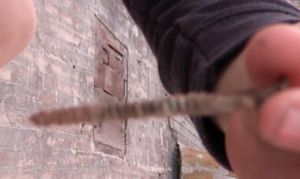
3″ bronze flat blade wood screws in some places went through deck into beams
The Ta-Shing shipyard in Taiwan used bronze flat blade wood screws on almost everything. These screws were the order of the day, and I am impressed that they are all bronze, but over time some of these have broken off at the head or slightly below the surface of the teak. I can tell where the boards had repairs done on them because they have stainless steel Phillips screws in them. The screws that used as replacements are about one and a half the diameter of the ones originally used and in most cases, the screws are not just where the bronze ones were missing. They are also about 3” to either side of every row of screws. So consider the primary issue here. We have screws that are going through the surface of the teak, uncovered and then proceed down through the top skin of fiberglass down into the deck core.
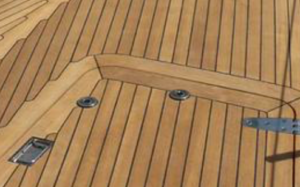
A Properly maintained deck with well-sealed bungs to cover screws
Not only did the manufacturer do this with a large volume of screws to hold the teak deck down, but whoever repaired this, or attempted to, added almost the same number of screws to the original number of screws that Ta-Shing used. So in my estimation, there are over 7000 holes in our deck.
Properly maintained, countersunk and bunged screws along with properly maintained teak would have avoided these problems for sure. But neglect can wreak havoc on a boat, and these decks have suffered that fate over time.
We made the tough decision to remove the teak decks and go over them with fiberglass. That decision is done and made at this point, and now it is a matter of finding the places where we have delimitation or core rot.
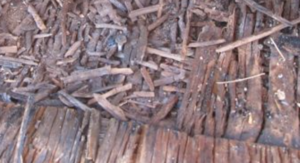
Sample of rotted Plywood, the layers have just come apart
Core Rot is easy enough to explain. It is where the material that used as a core between the two layers of fiberglass exposed to moisture over time, and eventually it rots. This exposure will make the wood spongy and soft and lose its ability to provide additional strength. If left in its current state it can begin to impact the structural stability of the boat. If you think about the deck of the boat, it is essentially the horizontal support holding the hull sides in place. When soft or spongy, the deck may give a bit here and a bit there allowing the hull sides to flex. I am certainly not shipwright but this is an obvious problem to me, and even just minor flexing will cause undo stress on all joints in a boat.
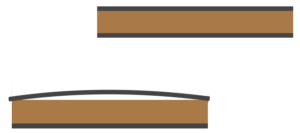
The lower image shows the top layer delaminated from
the wooden core
It can show up as small misalignments in cabinetry, door frames, and even all rigging through bolt positions as well.
Delimitation is a little harder for me to wrap my head around the actual impact. I will start by saying I know it is not good, but I don’t quite understand if the impact is as harmful from a structure standpoint as the rot. I presume it is and also must be corrected. Delimitation is when the layers of fiberglass have separated from the core, and the surface is no longer a tightly bound single unit but rather three individual layers.
I have both and I in most cases I am not sure which is the chicken and which is the egg. I suspect the thing that came first for us was the ingress of water. So once moisture has been able to get to the core, every time the weather drops below freezing that wood/water combo freezes and expands applying a bit of pressure to the bond between the fiberglass layers and the wood. That coupled with the moisture, humidity and freezing temperatures over time wiggles a little gap between the glass and core essentially breaking the bond between the surfaces. Think of plywood that was not glued together but rather just 3 layers stacked on top of each other. That is what we end up with in some places on the deck. The good news is that it is not everywhere and the easiest way to test for it is a tap test.
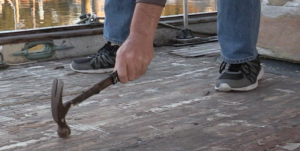
Performing a Tap test and listening for a hollow ‘thud’ sound
Take a small hammer and tap every 6-8 inches around the deck. Assuming you have some solid spots, you can hear a solid tap, tap, tap with each blow of the hammer. When you hit a spot that has delimitation or rot, the tap turns to a hollow thud sound. I started with cutting a few exploratory holes with a 2” hole saw on the port side deck, and in a sudden case of denial, last summer felt that the surface below was in pretty good shape in the area that I tested. I was pleasantly surprised but still in some disbelief that the core was hard wood and not plywood or balsa wood, but remained skeptical and in disbelief that could be the case. I poured epoxy into those exploratory holes months ago and continued with the deck.
The starboard deck would not let my most hopeful side assume this was ok. I did the tap test, or should I refer to it as the thud test. A section that was about 3 feet wide and 5 feet long all had a thud sound. It went from the edge of the coach house forward about 6 inches in from the toe rail. The issue seems to go down the sidewalk on the starboard side of the coach house as well, but I am focusing on the deck forward of that for now and will be working my way aft. I opted to not repair vast sections all at once due to time constraints and the challenge of working an area that large before epoxy were to kick or set but I am getting ahead of myself.
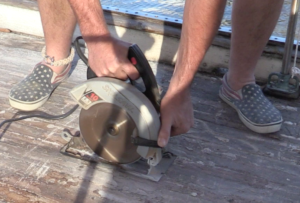
First cut with worn out saw. Did not work great but the
saw was in bad shape.
I needed more than a 2” hold to inspect the deck. I decided to start with a square about 16 inches each way. I swept the deck and pulled out my old and cheap circular saw that had a 140 tooth plywood blade on it. This blade wobbled a little as it cut into the fiberglass and it made me nervous. I then realized that I was ready to get a new saw that could be relied upon when needed. The old one had a bearing or something that was going in it, and the shaft had some wobble which is scary on many fronts. I opted to get a cordless saw and one that would use the same batteries and charger that my cordless drill use. I purchased the Milwaukee 6 1/2” circular saw and splurged a little and got a good 40 tooth Freud blade for veneer, finish work and plywood. I set the blade guard and fence so that the blade would only cut about 3/8” of an inch deep to allow it to get through the top layer of fiberglass but not too deep into the core. I laid the forward edge of the saw on the surface of the deck, held the blade guard open with my thumb while still holding the left-hand grip on the front of the saw. I aligned the blade direction and with my right hand flipped the safety switch, pulled the trigger and slowly lowered the saw into the work using the front tip of the fence/guard as the pivot point. Once the saw fence was flush on the deck, I could let go of the blade guard with my left thumb and slowly cut the deck. I did this in all 4 directions of my square being sure to overlap the cuts slightly so that the cut was all the way through and the corners of the opening met. This would prevent the bottom corner of fiberglass from cracking as the cutout piece is being removed. I was blown away by how good this little portable saw cut. I am looking forward to using this on many projects. When it first started, it sounded like the blade was going slower than other saws I have used, but I think it is just a lot quieter. It cut ten times better than the one I had previously.
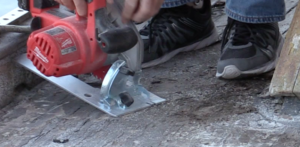
Using the new saw and pivoting it down into the deck through
the top layer of fiberglass
I laid the forward edge of the saw on the surface of the deck, held the blade guard open with my thumb while still holding the left-hand grip on the front of the saw. I aligned the blade direction and with my right hand flipped the safety switch, pulled the trigger and slowly lowered the saw into the work using the front tip of the fence/guard as the pivot point. Once the saw fence was flush on the deck, I could let go of the blade guard with my left thumb and slowly cut the deck. I did this in all 4 directions of my square being sure to overlap the cuts slightly so that the cut was all the way through and the corners of the opening met. This would prevent the bottom corner of fiberglass from cracking as the cutout piece is being removed. I was blown away by how good this little portable saw cut. I am looking forward to using this on many projects. When it first started, it sounded like the blade was going slower than other saws I have used, but I think it is just a lot quieter. It cut ten times better than the one I had previously.
The tools we use for this job are listed below if you find this a convenient way to shop for them. If you use these links, you get the same great Amazon pricing, but we get a small affiliate link credit. Thank you.
I then used a scraper and flat blade screwdriver and a mallet to tap the blade into the cut and pry the cut part up out of the opening. The best thing that could happen to you is that it is hard to come up. Sadly in my case, it came up pretty easily indicating that it did not adhere well to the core at all. I found a few spots that were stuck well, and in the photos, you can see why.
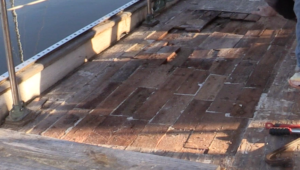
It was good to see that the deck was cored with hardwood
The core on this deck is a hardwood. The builder used pieces of hardwood that were about 3 1/2 inches wide and 9-12 inches long. They laid them long ways bow to stern and by using small pieces like this they were able to allow small gaps between the wood that would fill with epoxy resin when being built. This method of coring provided not only places where the fiberglass would stick to the wood, but where it would also stick to the epoxy bone structure that gets formed around each board holding the two layers of skin up. What I found in my case was wet wood. Some of the pieces were also soft and rotted, but not all of the, so this is good. I will replace them anyway and believe I have found the largest culprit for this rot.
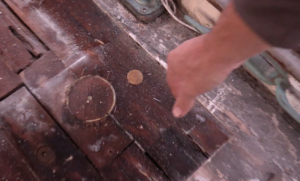
These are the likely original culprits for the water leaks into the
deck core. These are where the gas lines went through the deck
The starboard side of the deck held a deck box that also doubled as the propane locker for the galley stove at some point in the past. That meant that not only did the deck have large bolts that penetrated all the way through and bolted below. It also meant there was a large hole that went through the deck to allow for the gas lines into the boat. Over time these were ingress points for water, and the worst of my wet and rotted core is in the low spot just below the location of the deck box as well as all around these holes for bolts and gas line.
Next up – Removing the core and replacing it. The question now is plywood or hardwood?
If you want to see the video from this week showing this in some more detail, check it out below. Also feel free to subscribe to our channel on youtube and or follow us on Facebook where we will do facebook live videos at times as well. You can click the following link for our facebook page at https://www.facebook.com/SVDreamChaser/
Feel free to repost this article with embedded video to your favorite sailing group, sailing club or even point them to our youtube channel or Facebook channel for more info as well.

